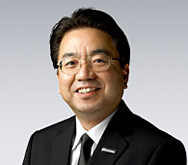Yoshiaki Kinoshita -Top Management- |
|
Q+A with Yoshiaki Kinoshita, Executive Vice President15.01.2009
What is the impact of the extension of engine life in 2009?
 We got the information about the three-race engine at the beginning of November and then in the middle of December we learned about the further changes to engine life, which also came with a drop in revs to 18,000rpm. Speaking from a technical point of view we didn’t have enough time to do a perfect job. Engine development is frozen but we can still work on areas such as the air box, the exhausts and the fuel so we put a lot of energy into improving the efficiency of the engine looking towards 2009. Therefore a change of this nature did present a challenge.
We got the information about the three-race engine at the beginning of November and then in the middle of December we learned about the further changes to engine life, which also came with a drop in revs to 18,000rpm. Speaking from a technical point of view we didn’t have enough time to do a perfect job. Engine development is frozen but we can still work on areas such as the air box, the exhausts and the fuel so we put a lot of energy into improving the efficiency of the engine looking towards 2009. Therefore a change of this nature did present a challenge.
Will this change have an impact on reliability?
Extending engine life, even when you drop the revs by 1,000rpm, definitely creates the potential for reliability issues. At Toyota, our approach is always to aim high and last season we achieved our target of 100% engine reliability; we had no race-ending issues. Total reliability remains our target despite the change and I am confident we can do this. I want the team to have the chance to use the engine in the same aggressive way we did last season, with no compromise on performance or reliability.
Are you allowed to alter the engine as a result of this regulation change?
Any changes would be for reliability purposes, so we are allowed to change elements of the engine in principle. But practically it is not as easy to make such changes in time for pre-season testing or even the first race. If you consider that design and production of a new crank shaft takes more than three months you can see that no-one has had time to react quickly by changing their engines. Time has been the most critical element and with the limited amount of testing we are allowed to do, it has made it particularly challenging.
Is there a performance impact?
We don’t want this change to have any affect at all on performance; that is our goal. It is much easier to extend engine life when you use it more conservatively. For parts like pistons, by turning down the engine’s rpm to 18,000 we can make its life longer but for some parts, such as castings, that alone does not guarantee reliability. The engine is a stressed member as a structural element between chassis and gearbox, so by extending engine life by 50% you are exposing the engine to 50% more vibrations, more kerbs and so on. Whenever you have a new car you can always expect some small problems initially because it is not possible to 100% predict the loads through the engine coming from the car.
Looking at the standard ECU, is this fully understood now?
In Formula 1 you can never say something works perfectly and we are never content with how we are using any particular element; we are always looking for improvement. With the standard ECU, we are now able to handle it much better. We have become used to its positive aspects and also used to its limitations. It has been a very busy year working on this device, with a lot of development, and that made for quite an expensive process. This year, as the second year of the standard ECU, is where we should begin to see its advantages from a cost-cutting point of view.
How much effort has gone into KERS so far?
We have deployed a lot of people on KERS because we had to cover not only electronic skills but also mechanical skills because you will have very high mechanical loads on this small device. On top of this we have a completely new area for us to be working on; the storage device. We continue to work flat-out to fine-tune our KERS so it is safe and it will provide a lap time advantage. They are our clear goals for this project.
What has been the focus in KERS development?
Producing a completely safe device is something we have been focusing on since the beginning. That means not only making the device completely safe in itself, but also training staff. We are still finalising this process. It is an ongoing activity and we are continuing to learn and improve.
